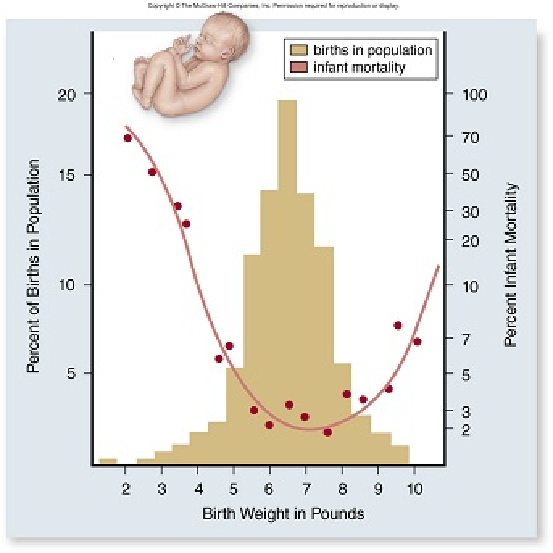In 1668, Francesco Redi performed a series of experiments on spontaneous generation. He began by putting similar pieces of meat into eight identical jars. Four jars were left open to the air, and four were sealed. He then did the same experiment with one variation: Instead of sealing four of the jars completely, he covered them with gauze (the gauze excluded the flies while allowing the meat to be exposed to air). In both experiments, he monitored the jars and recorded whether or not maggots (young flies) appeared in the meat. What hypothesis was being tested in the initial experiment with open vs sealed jars?
Ans: Maggots do not arise spontaneously, but from eggs laid by adult flies
You might also like to view...
In the graph below, which baby characteristics would explain the percent infant mortality curve and any subsequent effects on fitness?

A. The smaller the baby the better the chance of survival.
B. The baby needs to be small enough to survive after birth, but large enough for a safe delivery.
C. The baby needs to be large enough to survive after birth, but small enough for a safe delivery.
D. There is no correlation between birth weight and survival.
E. The larger the baby the better the chance of survival.
Clarify Question
· What is the key concept addressed by the question?
· What type of thinking is required?
· What key words does the question contain and what do they mean?
Gather Content
· What do you already know about fitness? How does it relate to the question?
Consider Possibilities
· What other information is related to the question? Which information is most useful?
Choose Answer
· Given what you now know, what information and/or problem solving approach is most likely to produce the correct answer?
Reflect on Process
· Did your problem-solving process lead you to the correct answer? If not, where did the process break down or lead you astray? How can you revise your approach to produce a more desirable result?
Imagine that a cell contains a genetic mutation in the gene encoding the primase enzyme, rendering it unable to
synthesize RNA strands. Assuming that all of the other enzymes directly involved in DNA replication are still functional in these cells, how much of the DNA replication process would you expect to see in these cells?
a. The leading strand would be synthesized, but not the lagging strand. b. No part of the DNA replication process could occur. c. The DNA helix would be unwound by helicase, but no new strands will be produced. d. Both the leading and lagging strand would be synthesized, but pieces of discontinuous strands would not be joined together. e. DNA replication would still proceed completely since RNA strands are not part of the final product of DNA replication.
Which of the following features is NOT an
important evolutionary advancement in the evolution of the tree dwelling primates? a. grasping hands and feet b. depth perception c. well-developed sense of smell d. the ability to see in 3D e. a large brain relative to body size
A vein always carries:a
blood to the heart. b. blood from the heart. c. oxygen-rich blood. d. oxygen-poor blood. e. blood rich in carbon dioxide.